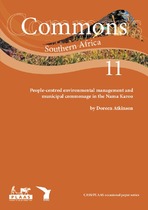| dc.description.abstract | Land reform is a key part of government policy, spurred politically by the claims of the landless, as well as the land reform pressures in countries like Zimbabwe. It is clear to national and provincial governments that land reform should be speeded up. Municipalities are, therefore, being placed under a lot of political and governmental pressure to increasingly make their commonage land available to emergent farmers.
The effective management of municipal commonage can contribute to land reform, food security, local economic development and sustainable natural resource use. Commonage land is, in many towns, the only natural resource available to poor communities. The issue of resource utilisation in the Karoo is becoming ever more pressing, to address the question of ‘how the vast and biologically diverse, but unproductive Karoo region should be used in a country with a growing land-hungry population’ (Dean & Milton 1999:xxii). This sets the stage
for an urgent inquiry into land-people interactions – particularly with reference to some kind of people-centred development – but as yet, this issue has not been confronted systematically in an interdisciplinary way.
This paper makes the following argument: Municipalities need assistance with establishing viable commonage management systems; such systems need to be based on the voluntary and committed participation by the users (that is ‘people-centred’); and this, in turn, requires an understanding of the emergent farmers’ knowledge base of the environment.
This paper considers the prospects for commonage use in the arid areas of South Africa, notably the Nama-Karoo, or non-succulent Karoo, characterised by small shrubs and grass species. This geographic area should be differentiated from the Succulent Karoo of the Namaqualand and southern Cape areas, which have different rainfall and vegetative patterns. The Nama Karoo is the northern part of the Karoo, and is the largest biome in South Africa. It is characterised by low and variable rainfall, mainly in the summer months. It stretches up to the southern Free State. This geographical demarcation is also significant because of its land tenure characteristics. The phenomenon of ‘commonage’ in the Nama-Karoo area refers to municipally-owned land, whose overriding purpose has been for the use of urban residents. | en_US |

